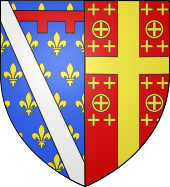Philip II, Prince of Taranto
This article needs additional citations for verification. (December 2009) |
| Philip II | |
|---|---|
| Prince of Achaea | |
| Reign | 1364–1373 |
| Predecessor | Robert, Prince of Taranto |
| Successor | Joanna I of Naples |
| Latin Emperor of Constantinople | |
| Reign | 1364–1373 |
| Predecessor | Robert, Prince of Taranto |
| Successor | James of Baux |
| Prince of Taranto | |
| Reign | 1364–1373 |
| Predecessor | Louis I of Naples |
| Successor | James of Baux |
| Born | 1329 |
| Died | 25 November 1373 Taranto |
| Spouse | Maria of Calabria Elizabeth of Slavonia |
| Issue | Philip Charles Philip Philip |
| House | Capetian House of Anjou |
| Father | Philip I, Prince of Taranto |
| Mother | Catherine of Valois–Courtenay |

Philip II (1329 – 25 November 1373) of the Angevin house, was Prince of Achaea and Taranto, and titular Latin Emperor of Constantinople (as Philip III) from 1364 to his death in 1373.
He was the son of Philip I of Taranto and Catherine of Valois.[2] Upon the execution of his cousin Charles, Duke of Durazzo, in 1348, he succeeded as King of Albania. Shortly after, his older brother Louis married their first cousin, Joanna I of Naples, and became king. In April 1355, Philip married Joanna's younger sister, Maria of Calabria.[3]
In 1364, Philip succeeded as titular Latin Emperor of Constantinople and Prince of Achaea and Taranto on the death of his oldest brother, Robert.
Maria died in 1366. On 20 October 1370, Philip married yet another Angevin, Elizabeth of Slavonia, former heir presumptive to the throne of Hungary. He died on 25 November 1373[4][5] in Taranto.
All his children had died young. His heir was his sister's son James of Baux.
He had several illegitimate children.
Family
By his first wife, Maria of Calabria, Philip had three short-lived sons: Philip (1356), Charles (1358), Philip (1360). They also had two stillborn children, in 1362 and 1366. By his second wife, Elisabeth of Slavonia, Philip had a son named Philip (1371).
Bibliography
- Giornale araldico-genealogico-diplomatico dell'Accademia araldica italiana. Vol. 4. Pisa: La direzione del giornale araldico. 1877.
- Giuseppe Pupillo; Operatori C.R.S.E.C. BA/7 (2017). Altamura, immagini e descrizioni storiche (PDF). Matera: Antezza Tipografi. ISBN 9788889313282. Archived from the original (PDF) on 21 October 2018. Retrieved 30 October 2018.
{{cite book}}: CS1 maint: numeric names: authors list (link) - Musto, Ronald G. (2003). Apocalypse in Rome: Cola di Rienzo and the Politics of the New Age. University of California Press.
References
- ^ giornale-araldico, pag. 276, quote: "Filippo II d'Anjou-Taranto (death: 1374), arma del padre"
- ^ Nicol 1984, p. 257.
- ^ Musto 2003, p. 78.
- ^ Jean Longnon, "L'Empire Latin de Constantinople et la Principauté de Morée", Paris, 1947, p. 332
- ^ Andreas Kiesewetter, Giovanna I d'Angiò, regina di Sicilia in Dizionario Biografico degli Italiani volume 55, 2001 read online
Sources
- Nicol, Donald M. (1984). The Despotate of Epiros, 1267-1479. Cambridge University Press.
